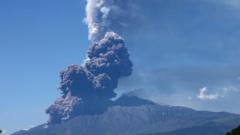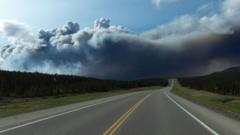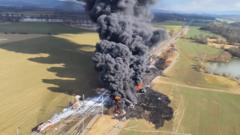As communities begin to rebuild, residents face serious health hazards from smoke and ash, prompting calls for action and assistance.
L.A. Wildfires Bring Lingering Health Risks Despite Home Salvage

L.A. Wildfires Bring Lingering Health Risks Despite Home Salvage
Toxic ash and smoke remain a concern for residents returning to fire-stricken areas of Los Angeles County.
In the wake of the devastating wildfires that swept through Altadena, a suburb in Los Angeles County, residents are confronting a harrowing reality. Despite some homes escaping flames due to the determined efforts of homeowners, like Matthew Craig who fought against the fire with little more than hoses hooked to a meager water supply, the repercussions of the wildfires extend beyond mere property loss.
The invisible danger lies within the toxins deposited by smoke and ash, which can infiltrate even the most secure homes. Craig, who said his family was "eating smoke," now faces the challenge of living in a home permeated by ash, soot, and debris. The toxic remnants of the fires introduce significant health risks that can linger for months, creating an environment unsuitable for living, especially for vulnerable populations like children and pets.
Experts warn that homes that are seemingly intact may still harbor dangerous chemicals released during the fire, as human-made materials—ranging from vehicles to plastics—burn and emit noxious fumes. Colleen Reid, a researcher from the University of Colorado Boulder, highlighted that while many families have lost everything, those fortunate enough to keep their homes are not exempt from health risks. “The wind will get through every crack,” she cautioned, emphasizing the pervasive nature of these toxins.
As communities grapple with the emotional and physical toll of the wildfires, the discussion around cleanup and long-term health implications has intensified. Residents are advised to take preventive measures, and local officials are urged to mobilize resources for support and assistance as the region begins the long process of recovery.
The invisible danger lies within the toxins deposited by smoke and ash, which can infiltrate even the most secure homes. Craig, who said his family was "eating smoke," now faces the challenge of living in a home permeated by ash, soot, and debris. The toxic remnants of the fires introduce significant health risks that can linger for months, creating an environment unsuitable for living, especially for vulnerable populations like children and pets.
Experts warn that homes that are seemingly intact may still harbor dangerous chemicals released during the fire, as human-made materials—ranging from vehicles to plastics—burn and emit noxious fumes. Colleen Reid, a researcher from the University of Colorado Boulder, highlighted that while many families have lost everything, those fortunate enough to keep their homes are not exempt from health risks. “The wind will get through every crack,” she cautioned, emphasizing the pervasive nature of these toxins.
As communities grapple with the emotional and physical toll of the wildfires, the discussion around cleanup and long-term health implications has intensified. Residents are advised to take preventive measures, and local officials are urged to mobilize resources for support and assistance as the region begins the long process of recovery.



















